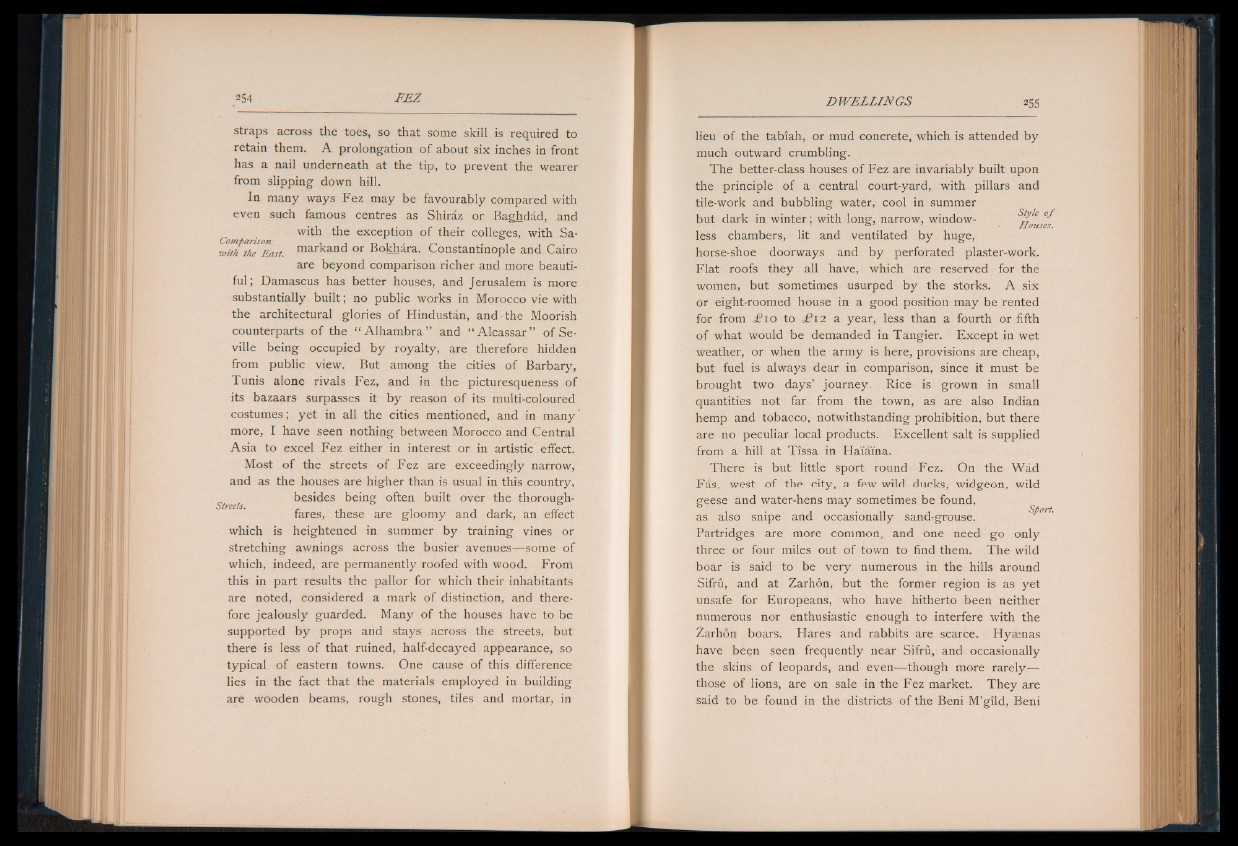
254 FE Z
straps across the toes, so that some skill is required to
retain them. A prolongation o f about six inches in front
has a nail underneath at the tip, to prevent the wearer
from slipping down hill.
In many ways Fez may be favourably compared with
even such famous centres as Shiráz or Baghdád, and
with the exception of their colleges, with Sa-
withTh^East. markand or Bokhára. Constantinople and Cairo
are beyond comparison richer and more beautiful;
Damascus has better houses, and Jerusalem is more
substantially built; no public works in Morocco vie with
the architectural glories of Hindustán, and the Moorish
counterparts of the “ Alhambra” and “ Alcassar” of Seville
being occupied by royalty, are therefore hidden
from public view. But among the cities of Barbary,
Tunis alone rivals Fez, and in the picturesqueness of
its bazaars surpasses it by reason of its multi-coloured
costumes; yet in all the cities mentioned, and in many'
more, I have seen nothing between Morocco and Central
Asia to excel Fez either in interest or in artistic effect.
Most of the streets o f Fez are exceedingly narrow,
and as the houses are higher than is usual in this country,
besides being often built over the thorough-
Streeis. r , , , fares, these are gloomy and dark, an effect
which is heightened in summer by training vines or
stretching awnings across the busier avenuesjjfsome of
which, indeed, are permanently roofed with wood. From
this in part results the pallor for which their inhabitants
are noted, considered a mark of distinction, and therefore
jealously guarded. Many of the houses have to be
supported by props and stays across the streets, but
there is less of that ruined, half-decayed appearance, so
typical of eastern towns. One cause of this difference
lies in the fact that the materials employed in building
are wooden beams, rough stones, tiles and mortar, in
DWELLINGS 255
lieu of the tabiah, or mud concrete, which is attended by
much outward crumbling.
The better-class houses of Fez are invariably built upon
the principle of a central court-yard, with pillars and
tile-work and bubbling water, cool in summer
but dark in winter; with long, narrow, window- SHo s {
less chambers, lit and ventilated by huge,
horse-shoe doorways and by perforated plaster-work.
Flat roofs they all have, which are reserved for the
women, but sometimes usurped by the storks. A six
or eight-roomed house in a good position may be rented
for from £ 10 to £ 12 a year, less than a fourth or fifth
of what would be demanded in Tangier. Except in wet
weather, or when the army is here, provisions are cheap,
but fuel is always dear in comparison, since it must be
brought two days’ journey. Rice is grown in small
quantities not far from the town, as are also Indian
hemp and tobacco, notwithstanding prohibition, but there
are no peculiar local products. Excellent salt is supplied
from a hill at Tissa in Haiaina.
There is but little sport round Fez. On the Wad
Fas, west of the city, a few wild ducks, widgeon, wild
geese and water-hens may sometimes be found,
as also snipe and occasionally sand-grouse.
Partridges are more common, and one need go only
three or four miles out of town to find them. The wild
boar is said to be very numerous in the hills around
Sifru, and at Zarhon, but the former region is as yet
unsafe for Europeans, who have hitherto been neither
numerous nor enthusiastic enough to interfere with the
Zarhon boars. Hares and rabbits are scarce. Hyaenas
have been seen frequently near Sifru, and occasionally
the skins of leopards, and even— though more rarely—
those of lions, are on sale in the Fez market. They are
said to be found in the districts of the Beni M’gild, Beni